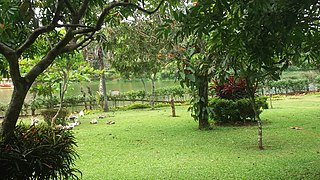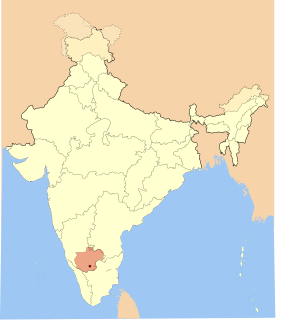
Karnataka is a state in the south western region of India. It was formed on 1 November 1956, with the passage of the States Reorganisation Act. Originally known as the State of Mysore, it was renamed Karnataka in 1973. The state corresponds to the Carnatic region. Its capital and largest city is Bangalore.

Kannada is a Dravidian language spoken predominantly by the people of Karnataka in the southwestern region of India. The language is also spoken by linguistic minorities in the states of Maharashtra, Andhra Pradesh, Tamil Nadu, Telangana, Kerala and Goa; and also by Kannadigas abroad. The language had roughly 43 million native speakers by 2011. Kannada is also spoken as a second and third language by over 12.9 million non-native speakers in Karnataka, which adds up to 56.9 million speakers. Kannada was the court language of some of the most powerful dynasties of south and central India, namely the Kadambas, Chalukyas, Rashtrakutas, Hoysalas and the Vijayanagara empire. It is one of the scheduled languages of India and the official and administrative language of the state of Karnataka.

The Hoysala Empire was a Kannadiga power originating from the Indian subcontinent that ruled most of what is now Karnataka, India between the 10th and the 14th centuries. The capital of the Hoysalas was initially located at Belur but was later moved to Halebidu.

Shravanabelagola is a town located near Channarayapatna of Hassan district in the Indian state of Karnataka and is 144 km from Bengaluru. The Gommateshwara Bahubali statue at Shravanabelagola is one of the most important tirthas in Jainism, one that reached a peak in architectural and sculptural activity under the patronage of Western Ganga dynasty of Talakad. Chandragupta Maurya is said to have died here in 298 BCE after he became a Jain monk and assumed an ascetic life style.

Tulu is a Dravidian language whose speakers are concentrated in Dakshina Kannada and the southern part of Udupi of Karnataka in south-western India and in the northern part of the Kasaragod district of Kerala. The native speakers of Tulu are referred to as Tuluva or Tulu people and the geographical area is unofficially called Tulu Nadu.
The Kannada people or Kannadigas, are a Dravidian ethno-linguistic group who trace their ancestry to the South Indian state of Karnataka in India and its surrounding regions. Kannada belongs to the Dravidian family of languages. An alternate English demonym for Kannadigas in modern works of history is "Kanarese". Modern Kannada stands among 30 of the most widely spoken languages of the world as of 2001.

Kolar districtpronunciation (help·info)) is a district in the state of Karnataka, India.

Dakshina Kannada is a district of Karnataka state in India, with its headquarters in the coastal city of Mangalore. It is part of the larger Tulu Nadu region. The district covers an area nestled in between the Western Ghats to its east and the Arabian Sea to its west. Dakshina Kannada receives abundant rainfall during the Indian monsoon. It is bordered by Udupi district to the north, Chikmagalur district to the northeast, Hassan district to the east, Kodagu to the southeast and Kasaragod district of Kerala to the south. According to the 2011 census of India, Dakshina Kannada district had a population of 2,083,625. It is the only district in Karnataka state to have all modes of transport like road, rail, water and air due to the presence of a major hub, Mangalore. This financial district is also known as the Cradle of Indian banking.

The Kadambas were an ancient royal family of Karnataka, India, that ruled northern Karnataka and the Konkan from Banavasi in present-day Uttara Kannada district. The kingdom was founded by Mayurasharma in c. 345, and at later times showed the potential of developing into imperial proportions. An indication of their imperial ambitions is provided by the titles and epithets assumed by its rulers, and the marital relations they kept with other kingdoms and empires, such as the Vakatakas and Guptas of northern India. Mayurasharma defeated the armies of the Pallavas of Kanchi possibly with the help of some native tribes and claimed sovereignty. The Kadamba power reached its peak during the rule of Kakusthavarma.

Western Ganga was an important ruling dynasty of ancient Karnataka in India which lasted from about 350 to 1000 CE. They are known as "Western Gangas" to distinguish them from the Eastern Gangas who in later centuries ruled over Kalinga. The general belief is that the Western Gangas began their rule during a time when multiple native clans asserted their freedom due to the weakening of the Pallava empire in South India, a geo-political event sometimes attributed to the southern conquests of Samudra Gupta. The Western Ganga sovereignty lasted from about 350 to 550 CE, initially ruling from Kolar and later, moving their capital to Talakadu on the banks of the Kaveri River in modern Mysore district.

The Halmidi inscription is the oldest known Kannada language inscription in the Kadamba script. While estimates vary slightly, the inscription is often dated to between 450 CE - 500 CE. The inscription was discovered in 1936 by Dr. M. H. Krishna, the Director of Archaeology of the (princely) State of Mysore, in Halmidi, a village in the Hassan district.

Shimoga district, officially known as Shivamogga district, is a district in the Karnataka state of India. A major part of Shimoga district lies in the Malnad region or the Sahyadri. Shimoga city is its administrative centre. Jog Falls view point is a major tourist attraction. As of 2011 Shimoga district has a population of 1,752,753. There are seven taluks: Soraba, Sagara, Hosanagar, Shimoga, Shikaripura, Thirthahalli, and Bhadravathi. Channagiri and Honnali were part of Shimoga district until 1997 when they became part of the newly formed Davanagere district.

The history of Karnataka goes back more than two thousand years ago. Several great empires and dynasties have ruled over Karnataka and have contributed greatly to the history, culture and development of Karnataka

Gubbi Hampanna Veeranna was an Indian theatre director. He was one of the pioneers and most prolific contributors to Kannada theatre. He established the drama company, Gubbi Sree Channabasaveshwara Nataka Company, which played a crucial role in promoting the Kannada theatre field. He has been conferred the title Nataka Ratna meaning "A Precious Jewel" in the theatre world.

The earliest undisputed deciphered epigraphy found in India are the Edicts of Ashoka of the 3rd century BCE, in the Brahmi script.
Old Kannada or Halegannada is the Kannada language which transformed from Purvada halegannada or Pre-old Kannada during the reign of the Kadambas of Banavasi.
Karnataka is a state in the southern part of India. It was created on 1 November 1956, with the passing of the States Reorganisation Act. Karnataka is bordered by the Arabian Sea to the west, Goa to the north-west, Maharashtra to the north, Telangana and Andhra Pradesh to the east, Tamil Nadu to the south-east, and Kerala to the south-west. The state covers an area of 74,122 sq mi (191,976 km2), or 5.83% of the total geographical area of India. It comprises 30 districts. Kannada is the official language of Karnataka and the 2011 census is the mother tongue of 66.5% of the population. Various ethnic groups with origins in other parts of India have unique customs and use languages at home other than Kannada, adding to the cultural diversity of the state. Other significant linguistic minorities in the state in 2011 were speakers of Urdu (10.8%), Telugu (5.8%), Tamil (3.5%), Marathi (3.4%), Hindi (3.2%), Tulu (2.6%), Konkani (1.3%) and Malayalam (1.3%).

Government Museum, Bangalore, established in 1865 by the Mysore State with the guidance of Surgeon Edward Balfour who founded the museum in Madras and supported by the Chief Commissioner of Mysore, L.B. Bowring, is one of the oldest museums in India and the second oldest museum in South India. It is now an archaeological museum and has a rare collection of archaeological and geological artifacts including old jewellery, sculpture, coins and inscriptions. The museum is also home to the Halmidi inscription, the earliest Kannada inscription.

About 25,000 inscriptions found in Karnataka and states near by belongs to Kannada rulers like Kadambas, Western Ganga Dynasty, Rashtrakuta, Chalukya, Hoysala and Vijayanagara Empire. Many inscriptions related to Jainism are unearthed. The inscriptions generally found are on stone (Shilashasana) or copper plates (Tamarashasana). The Kannada inscriptions found on historical Hero Stone, coin and temple wall, piller, tablet and rock edict. These Inscription have contributed towards Kannada literature and helped to classify as Proto Kannada, Pre Old Kannada, Old Kannada, Middle Kannada and New KannadaInscriptions depicts culture, tradition and prosperity of those era. The world wide recognized literature Ramayana and Mahabharata are transferred through generation by these Inscription Hazara Rama Temple and Aranmula Parthasarathy Temple are the best example.

Bangalore, officially known as Bengaluru, is the capital and the largest city of the Indian state of Karnataka. It has a population of more than 8 million and a metropolitan population of around 11 million, making it the third most populous city and fifth most populous urban agglomeration in India. Located in southern India on the Deccan Plateau, at a height of over 900 m (3,000 ft) above sea level, Bangalore is known for its pleasant climate throughout the year. Its elevation is the highest among the major cities of India.



















